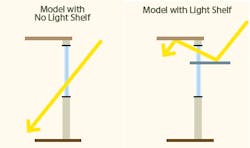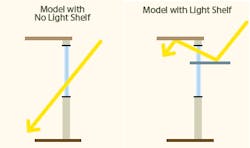Building the Case for Light Shelves
By Michael A. Barber
While light shelves help redistribute the sun's direct visible energy deep into a building, they also reduce the amount of radiant energy at the building's perimeter (which, in turn, reduces the building's cooling load and associated energy consumption). The integration of light shelves to create high-performance building design requires a team approach since, not only are the building aesthetics a consideration, the visual and thermal environments are major design factors as well.
The design and application of light shelves requires some common sense and careful analysis. The following rules of thumb are relevant for projects located in the Northern Hemisphere:
- Light shelves are most effective with south-facing glass.
- Light shelves are not very effective with east- and west-facing glass. Limiting the size of windows and using blinds or shades are more effective ways to minimize thermal
- heat gain and control glare from the low sun angles on these exposures.
- Light shelves are not effective with north-facing glass. North-facing skies provide diffuse daylight rather than direct sunlight for much of the year.
- Light shelves are not very effective on any building where the number of overcast days is significantly higher than the number of clear, sunny days at the project location.
- Matte is the recommended finish for the top of the light shelf to diffuse the direct sunlight, which will minimize glare and provide uniform distribution of light inside the room. (Highly specular finishes are currently being studied to maximize daylight penetration; however, diffuse finishes are recommended until more information and design guidelines are defined.)
Now, to the careful analysis: To illustrate the light shelf's effectiveness, two computer models were prepared - one with a light shelf, the other without. Properties of the model spaces are defined in Properties of the Model Space (see sidebar and graphic).
A number of daylight calculations were performed at different times of the year under varying sky conditions within the room at 2-feet, 6-inches above the finished floor. The calculation was performed for Philadelphia on April 21 at noon under clear-sky conditions. The calculations were performed using Lumen Designer lighting software. The first observation should be the extremely high light levels closest to the window in the office with no light shelf. This begins to tell an even greater story about the light quality and characteristics within the space - the most telling being the uniformity.
It is critical to balance the uniformity of illumination at the work plane and in the immediate visual environment. Uniformity allows us to focus on visual tasks and reduces eye strain. Recent studies (Heschong Mahone Group Inc., 1999, 2001, 2003) have shown that student performance on test scores increased significantly in classrooms with a properly designed daylighting system - one that balances illumination levels and uniformity, and reduces direct glare.
Michael A. Barber, LEED AP, is a principal at The Lighting Practice Inc. (www.thelightingpractice.com), Philadelphia, which provides specialized design services in the application of lighting for architecture.

